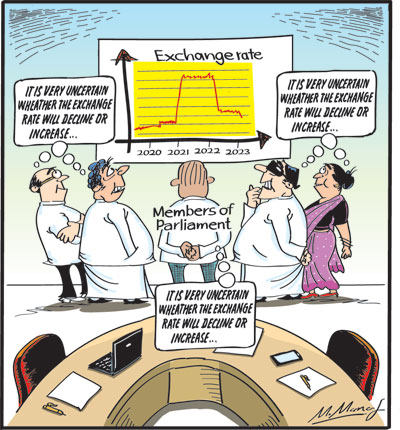Columns
Uncertainty in the country’s exchange rate likely to continue
View(s): The exchange rate took a huge plunge recently, then steadied to some extent and continues to fluctuate within a narrow range. What lies ahead with respect to the exchange rate is quite uncertain.
The exchange rate took a huge plunge recently, then steadied to some extent and continues to fluctuate within a narrow range. What lies ahead with respect to the exchange rate is quite uncertain.
An optimistic view
The exchange rate appreciation is the big news, and in a main scenario, while there might be some deprecation of the dollar from now, it is unlikely to depreciate to the Rs 360 levels it was at.
Foreign flows into Sri Lanka’s domestic debt market are creating a positive effect. This is not very contrarian given it’s a view that is in line with current market levels.
The IMF in the documents released at the time of the board-level talks had an implied exchange rate which was more adverse than the expected rate projected.
But beyond this, in many other aspects, we are very much in line with the IMF projections.
The IMF is working with an expectation of lower rates. This is quite realistic in the context of the current and foreseeable state of the external finances.
While growth will resume slowly from the second half or even continue to contract, the external finances are expected to improve. It will be a negative growth for the full year and slow growth in 2024.
Though GDP is not always correlated, this is also the kind of recovery we see in consumer demand and purchasing power. Sharply lower inflation will also start to help in stabilisation and then a recovery of consumer demand.
Restructuring debt
The risk is that debt restructuring takes too much time — derailing the IMF programme.
Politics is another big risk as the IMF is seen to be causing pain. Politicians and parties will see advantages in opposing the programme.
The other major risk is bank runs if the messaging of the DDO is not handled properly including the messaging on it.
Foreign funds
The upside is even more foreign money comes into local debt than we anticipated. Others include tourism which is doing better than expected and a reduction in global oil prices.
If state-owned enterprises (SOE) and other asset sales happen well and fast, it is really worth considering. However, the uncertain factor is the opposition to the restructuring of SOEs. Several parties, including the Pohottuwa which controls the majority, have said they are opposed to privatisation. How the government could overcome this obstacle remains a mystery. This is apart from the fact that several political parties have said that they are opposed to many IMF reforms, including the privatisation of especially profit-making state enterprises.
Tourism
As mentioned earlier, earnings from tourism are one of the bright spots in the country’s external finances. Already, in the first four months, tourist arrivals have exceeded the expected numbers. Even if there is a dip in tourists in the next few months, arrivals are expected to increase sharply in the winter season. The expectation is that tourist earnings will exceed US$ 4 billion. There are, of course, risks such as political and social up-heavals, the spread of dengue and Covid, and a further global recession. However, it appears that the increasing cost of living in developed countries has made tourist out-flows attractive as the cost of living in Sri Lanka is much less than in their home countries.
Remittances
The other favourable development is that remittances are growing. It is likely that remit-tances would exceed US$ 5 billion. The developments in the foreign exchange markets are likely to enhance remittances through official banking sources.
Together the remittances and tourist earnings are likely to bring in around US$ 12 billion. This is what would boost the reserves. In addition, there are indications that international assistance in the form of project loans would enhance the reserves.
Trade balance
While these improvements would be substantial gains, the trade balance is likely to deteriorate. The trade deficit is expected to widen owing to a fall in manufactured exports. The global recession that has depressed demand for our manufactured items is likely to have an adverse impact on trade. There are no signs of the global recession abating and as such the country’s export industries which have also been affected by high costs of fuel, raw material, and electricity are likely to contract significantly. Therefore, prospects of economic growth remain in jeopardy although the external finances of the country are likely to improve.
Summing up
Although the economy is not likely to revive, an improvement in the external finances is likely owing to increased remittances and tourist earnings. These would more than offset the expected trade deficit for this year and strengthen the reserves. Consequently, the exchange rate of the rupee is likely to strengthen further. An exchange rate doing better, interest rates falling, and the economy not growing are what to be expected but there are significant risks to also consider.
Exchange rate
An often misunderstood factor is the exchange rate. The popular perception is that an appreciation of the rupee is a favourable development. In fact, the appreciation of the rupee would increase imports and decrease exports. What is realistic is for the exchange rate to be market determined whether Sri Lanka would permit a market-determined ex-change rate or intervene to strengthen the rupee remains an important factor.
Conclusion
Paradoxically the economy is not likely to revive this year. However, the external finances are likely to strengthen.
Buying or selling electronics has never been easier with the help of Hitad.lk! We, at Hitad.lk, hear your needs and endeavour to provide you with the perfect listings of electronics; because we have listings for nearly anything! Search for your favourite electronic items for sale on Hitad.lk today!


Leave a Reply
Post Comment